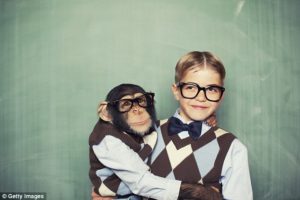
I’ve been reading the animal behavior literature for a few decades now. There is some excellent work by dozens of researchers exploring how animals behave and learn and remember and problem solve. We have learned so much about how animals have adapted to their environments and function in their particular niche. They can be quite clever in many ways, yet there seems to be this strong reluctance to admit the obvious, that the human animal along with being just another critter running on the same body plan, using the same or very similar DNA, genes, proteins, hormones, neurotransmitters, and neurons in the brain, is still a qualitatively different creature altogether when it comes to consciousness and cognition.

The growth of human civilization and our impact on the earth for good or for bad, accomplished through science, technology, and socio-cultural advance is phenomenally different from what animals have done on the planet. We theorize, and build, and do language and music, and make machines, and travel in space, etc.,etc. Our cognition and behaviors are unprecedented on the planet, yet it seems to be a difficult thing to admit, almost a terrible truth to be avoided, that ultimately we are cognitively very different, qualitatively so, and that evolved difference in cognition is what has produced all our accomplishments. Our possibly unlimited conceptual abilities, that allow us to theorize, experiment, and learn how the world works, i.e., causally understand why and how things work the way they do, appear to be unique to the human animal…and this is not to be acknowldeged. There is an almost desperate, however well-meaning, attempt to make sure that whatever we find to be true of other animal’s cognitive abilities, we must proclaim “they are more like us than not like us”, in fact nearly “just like us”, when they are not. Just ask your dog.
Chimps and other clever animals (rats, dogs, or crows, for example) can learn some impressive behaviors, definitely, but it seems to be mostly by repetitive trial and error, learning what works, but not WHY any behavior works, which even a human child catches on to, and often in only one or two trials. In addition animal learning is mostly limited to one specific domain, which they use naturally and can be quite adept at.

Rats for example have excellent spatial memories. They learn complex mazes that we never seem to run dogs, chimps, or crows through. (I’ve picked these 4 critters to discuss as they have been well studied, exhibit some truly clever learning capacities, and are among the most intelligent of animals, each in their own way.) Rats forage for new food sources at night. With poor eyesight, but an excellent sense of smell and spatial memory they sniff and feel their way along with their whiskers and when they find something new they haven’t smelled before, they will only nibble a bit, to sample it as it were, and if they dont get sick: i.e. it is not poisonous to them, they just found a new food source. They will be back the next night, finding their way back, guided by smell and by remembering the turns and runs they made to get to that food. Its why they are so good at mazes, other animals not so much. Rats are endowed with a formidable spatial memory and one-trial poison-aversion learning.
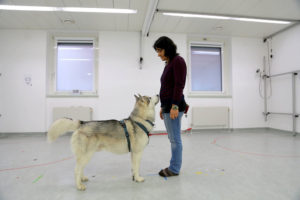
Your dog, similarly possessing an excellent sense of smell, but not the best eyesight, not like a hawk’s or an owl’s or ours, but certainly better than a rat’s, also has excellent hearing, which it uses along with smell and sight to find its prey/food. In addition, dogs excel at various aspects of social cognition such as watching our eyes, reading our emotions, and sharing attention with us. They will follow our gaze or point and look at what we look at or indicate, nearly as good as a young human child. We can train dogs on all sorts of behaviors we can’t train our pet rat to do. Rats can learn to press levers for food and water, and run complex mazes, way better than your dog, but that’s about it. Your dog has his cognitive skill set, tuned to paying attention to the smells and sounds around him and to other dogs when they work together in cooperative hunting to take down prey, and to us. His intelligence is very different than a rat’s, and just as focused, but on a wholly different domain of behaviors.
Chimps don’t learn all the tricks we teach your dog so well, and aren’t adept at social cognition as dogs are, despite living in troops of 30-80 individuals and engaging in almost Machiavellian levels of social interactions. There is constant confrontation, grooming, grudge-holding, revenge, shifting alliances, challenges to the alpha male, etc., yet they don’t look one another in the eye, their social interactions don’t employ the eyes and facial communication anything like humans and dogs. Even the mother-infant chimp pair rarely make eye contact. It isn’t needed in their social interactions and not how they communicate, which is so different from the constant eye contact we humans make with each other…and with our puppies, but not our cats. Chimps aren’t so good at gaze or point following when compared to your dog or your 3 year-old, who both engage in joint attention regularly.

However, chimps are very good at learning manipulative skills that your dog has little to no aptitude for. In the wild they learn to fish for termites with a stick they have modified by pulling the leaves off, or crack open nuts using rocks as a hammer and anvil. Additionally, they have excellent visual memory and hand-eye coordination (they are true natural acrobats swinging thru the trees like many other primates) and can remember positions of numbers on a screen faster and better than us humans can. They will figure out how to unravel a rope they are tied to from around a tree allowing them to reach a food reward some feet away. Your dog, clever as he is at watching your eyes to read your emotions or share your attention, will never figure that one out. He will wrap his leash around the same bush and get stuck time after time when you let him out: Dumb as a box of rocks on that one. Its just not in his cognitive repertoire, any more than a rat in following your gaze or point, or a chimp running through a complex maze like a rat. Animals have very specific, evolved cognitive capacities that serve them well in adapting to their particular niche.
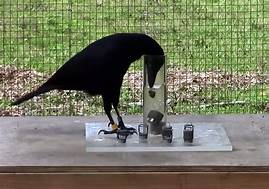
Crows and other corvids (ravens, rooks, jays, magpies, etc.) are among the cleverest of birds. They can learn to bend a paper clip to slip into a curved test tube and fish out a morsel of food or hook a small container holding a food reward. Fishing for grubs out of tree bark with small twigs, sometimes bent, as an extension of their beak, is something they do in the wild, so they are adept at manipulating small tools as extensions of their beaks in the lab. Trying to get a rat, as smart as they are with mazes and lever pressing, to hold anything in its mouth and cleverly manipulate it like a crow is next to impossible. Corvids can also learn to chain together a series of behaviors to access a food reward: pull up a string, hold it with their feet, insert a stick to open a box, get a rock out of the box to drop into another box to open it, to grab a stick with which to stab food, for example: again with extensive training as is so common in most animal behavior training, sometimes taking dozens, hundreds of trials for them to learn a given behavior or set of behaviors. But crows don’t do well at social-cognitive tasks like your dog, or mazes like a rat. Impressive intelligence, but limited to a few related behaviors.
What all these most clever of animals appear to lack is not only a general intelligence, allowing them to learn tasks and acquire new behaviors in many domains, but a causal, theoretical, conceptual intelligence, that only humans appear to have, which develops very early, beginning in infancy.
Animal researcher Daniel Povinelli has a body of work from nearly 3 decades of investigating chimpanzee and human child intelligence. The upshot of his work is that chimpanzees do not have any sort of causal understanding, lacking what he calls the recognition of “un-observable concepts”: things like weight, support, containment, contact, and propulsion that your young child and even infant develop early on and use to learn about their environment. We have, it seems a unique conceptual intelligence that allows us to develop all manner of un-observable or abstract spatial, structural, and force relations between objects in our environment and between concepts themselves. The link highlighted above: “conceptual intelligence” goes into detail on how I define concepts. Our conceptual ability gives us the general intelligence to problem solve our way through any environment, learn in many domains of behavior, and very quickly, often in one or two trials. We approach nearly everything in our daily life as something to be figured out, a problem to solve, using our causal understanding given by those conceptual abilities.
A good sampling of Povinelli’s comparisons of chimp learning and child learning is seen at the 9:00-19:00 minute section of the excellent PBS series “The Human Spark”, narrated by Alan Alda: Human Spark-Chimps vs.Children. The entire episode is worth watching as is the entire series, but this ten minute segment really focuses on the profound differences in our cognition versus the chimps, being among the cleverest of the animals.
Chimps and other animals often require dozens, sometimes hundreds of trials to learn a behavior. According to Povinelli, chimps never “get it.” They never come to understand WHY a behavior works, or that some causal process is even occurring, whereas children approach their world and specific tasks as if there is something going on to be discovered and figured out, using un-observable concepts. From all I’ve read in the comparative psychology-animal behavior literature and from my own field: Developmental Psychology, I wholeheartedly agree with his conclusion. I’ve written recently on that topic: our innate motivation and talent for understanding causal processes HERE.
Rather often in the animal behavior studies, it is assumed animals are using concepts and other cognitive processes to produce a behavior, in the same way as a human would, when the behavior in question could be done by the animal with simple rule governed behavior, not requiring any thinking or conceptual understanding at all: and this despite there is no evidence for and much negative evidence, as in Povinelli’s work, that animals are not using concepts, and never seem to catch on to what causal processes may be operating.
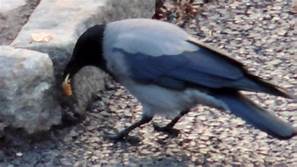
An example from the comparative psychology literature on Corvids: ravens, crows, rooks,…the cleverest birds out there will demonstrate what I mean. Corvids will cache (hide) food. They hide worms and nuts to eat later. They will re-hide food afterwards if another bird was present when they were hiding their food. One interpretation for this re-caching behavior is that Corvids have a Theory of Mind (ToM) and the bird caching his food “knows” the other bird “saw” where he hid the food and remembers this “episode” and therefore thinks:
“He saw me, and knows where my food is so I need to re-hide my food so he doesn’t get it”.
They are claimed to have a sort of “episodic memory” and remember “events” in their personal experience, just like a human. They are often assumed to be using that Theory of Mind (ToM) like humans do where we assume what someone else is thinking or feeling or knows about: that they have a mind like our own. That is assuming one hell of a lot of concepts, (which I highlighted in bold above), that the Corvid must have an understanding of, and then use such concepts to think and guide his food re-caching behavior. That might be the way WE would do it, to plan a future behavior, by thinking about it in a conceptual and causal, logical narrative, but that is not necessarily how a bird’s brain does it. The bird may be following a simple perceptual-empirical rule:
“If a con-specific (another similar bird) is present, re-hide food.”
That’s all that is needed to run the re-caching behavior. No thinking, no ToM necessary, no concepts of knowing or events.
Episodic memory in humans develops after age 3-4 when the child begins to construct memories of events in their life, with them as the main actor in the event, which they build upon every day of the rest of their lives. We as adults can travel back and forth in time automatically, recalling past episodes in our lives, and imaging future ones. This has been termed “autonoesis” by the cognitive psychologist Endel Tulving. We are not born with it. It takes 4 years to develop in the child. One must master the concept of “event” first: an abstract concept of a specific action performed in a distinct period of time like: “getting dressed” “going to the store” or “baking cookies”. The child has to frame that event in a finite space of time with a beginning, middle, and end (the start of narrative thinking). There is a whole literature on event understanding and narrative in child development, foremost by the cognitive development researcher Katherine Nelson. The child needs to first develop a sense of a duration of time, that time passes (a spatial metaphor, which is one way we represent, or conceive of time, another un-observable concept that animals show no awareness of) and that the event like “baking cookies” has specific actions that start, proceed, and then end with. There’s a lot of conceptual content to having anything resembling episodic memory, yet Corvids food re-caching actions are described in those terms. Furthermore, it takes to age 3-4 for the child’s concept of self to develop enough to be included in the events they experience, which is what makes events episodes in their own life.

All of our episodes in our huge episodic memories contain a lifetime of similar events: we all had birthdays, we went to grade school, learned to drive, graduated from school, but our individual episodes are unique to each of us. We build on that episodic memory store daily and access it constantly throughout the day in our persistent recalling of things we did, and in imagining what we will do in the future. Adults create future memories, episodes that haven’t happened yet, in their repeated planning ahead. Kids don’t do much of that future planning until after ages 5-6. Episodic memory requires years of conceptual development in the human child.
Somebody tell me how animals, any animal, gets to having anything like episodic memories without the stages a human child must go through in building their cognition, including all the necessary concepts that comprise what an episode is. So when some animal researcher titles a paper about a raven re-hiding food:
“Episodic memory in…” , I go crazy.
Being able to remember past behaviors and perceptions is surely evident in animals. They remember sights and sounds and smells, and locations, and actions, but there is no evidence they re-represent those perceptual memories in conceptually-laden events in their own lives; episodes. You would need to also assume the animal (a Corvid in this example) organizes their memories in events which means they must have some concept of time and of specific actions, and add in a self-concept to make for a personal “episode” like a human. There is no evidence they have any of those concepts. It is absurd to use the term “episodic memory” in reference to animal behavior. The use of that term was attacked enough by other researchers, that the author conceded to re-title the paper:
“Episodic-like memory in Corvids.”
That is still more than a bit of a stretch! It should be titled something like:
“Food re-caching behavior in the presence of con-specifics in Corvids.”
Now that would be a cautious, realistic title any self-respecting scientist should employ.
For another example of complex behavior that resembles ours and can look like episodic memory and thought may be employed, consider that squirrels hide hundreds of nuts for winter and later find many of them…not because they remember the hiding places and exactly when they put them there as we might, thinking:
“Oh yeah, I hid a bunch of nuts by that far tree over there, and just before it got real cold.”
That would be employing an episodic memory event that includes, where, when and one’s self as an agent acting a specific behavior in a specific time frame.
Instead, they have an overall spatial map in their memory of the particular yard they hid nuts in (and the shelves in my open garage) and go over and over that territory all winter randomly digging and sniffing, often finding many if not most of their caches. No memory of each hiding event, no thinking necessary. Simple spatial memory and acute perception (sense of smell) does the job. No higher, human-like cognition involved…and often they don’t find the nuts they hid behind boxes or tools on the shelves in my garage. (They do have some rather clever hiding places). What a corvid or squirrel does is nothing like employing our episodic memory store. This misuse, or loose application of human psychological terms to describe animal behavior: like “episodic memory” or “consciousness” (a whole other essay), may be a reflection of our tendency to anthropomorphize, that is, ascribe human like traits to other animals, exemplified in our “Disney culture”, where we see animals depicted talking and thinking exactly like humans our entire lives. In addition this humanizing appears to support the seeming need for many researchers and the general public to proclaim of animals:
“Oh golly, aren’t they are just like us!”
There are 2 key caveats that scientists like Povinelli and other researchers remind us of as an antidote to our anthropomorphizing:
1. We cannot assume the animal has the same psychology as us when they perform similar behaviors (Morgan’s Canon).
2. Most experimental designs/observations in comparative psychology cannot distinguish between simple behavioral rules and claims about animals using concepts and logic, such as ToM and un-observable causal relations and processes, or simple spatial relations.

For example, we humans starting at a very early age see “in” : a spatial relationship termed “containment” between objects and containers. Consider the young toddlers “allgone” gesture that we teach all young kids. They have the ability to understand containment (or lack of it) across different perceptual scenes. They hold up their sippy cup and show you it is empty: “allgone”, they cant find their doll in their toybox: “allgone” and they notice Mommy left the room and isn’t there: “Where’s Mommy?” “allgone”
Those 3 instances require a concept of containment: something being “in” something else, and in this example all 3 instances are lack of containment: the juice is not “in” the cup, the toy is not “in” the toybox, Mommy isnt “in” the room. They key point is there is no perceptual similarity between those 3 situations. Animal perceptual categorization doesn’t work for abstract un-observable concepts like containment: something being in something else. You have to be able to abstract that relationship between the containers and what they contain as all being similar, a spatial relation of container and the thing in it (or out of it).
It seems in child development, all sorts of spatial relation concepts, all truly un-observable, come first: “containment” “support” (objects need to be supported or they will fall off), or “contact” (things must be touching, lying on, held by something else for them to move together), for example. Chimps suck at this one, as demonstrated by a number of Povinelli’s multiple experiments. A kid will understand a toy must be fully on the blanket to be able to drag it to them, the chimp will yank the blanket if the toy is not touching, or just barely touching when we know it will just slip off, but the chimp will make the same mistake again and again…they never “get it”!
For another example of very young humans employing abstract, un-observable concepts, infants conceptualize living from non-living things not by perceptual similarity, but from the abstracted ideas of “self-movement” and “responsiveness.” Balls and cups and toys and objects of all kinds never move by themselves like Mommy and big brother and kitty do. And they don’t respond either, no matter what you do to them. But Mom hugs back and big brother talks back to you and kitty responds when you pick her up. Objects just sit there, they don’t do anything in response to what you do to them, and need to be propelled to move, they never move by themselves. The cognitive development researcher Jean Mandler has shown that some of the first conceptualizations infants discover is “living” versus “non-living” comprised mostly of people and animals versus objects in just the first year of life. There is no evidence that animals have any such concepts. The subject of another essay here will be animal responses to dead animals and if they have any concept at all of what it is for a creature to be alive, be ill, or experience death. Children develop their concepts of life and death over the first 5-8 years, starting with the distinction of behaviors of living versus non-living things.
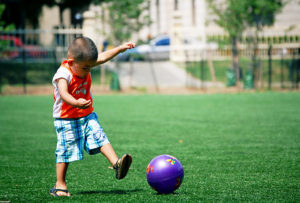
“Propulsion” is another early spatial-force-movement concept a child can abstract from interacting and observing all sorts of normal actions on objects and what they normally do. Objects (non-living things) don’t move unless you move them, make contact and propel them in some way: throw, kick, push, pick up, etc.
The human brain is wired to do all this conceptualization early on. There is no evidence other animals do any conceptualization, as even the smartest and closest to us genetically, our chimp cousins fail at spatial concepts, much less further abstracted ones. It takes a human child, already full of spatial concepts since infancy, 3-4 years to achieve ToM and ascribe mental states to others, recognizing others have a “mind” too, and “thoughts”, and “knowledge” like they themselves do. Episodic memory and the many concepts it requires begins to appear in the human child around the same time.
It is a long developmental road to get humans up to speed on all our conceptual abilities. Not only is there no evidence in the voluminous animal literature for conceptual abilities in other critters, it doesn’t happen overnight in humans. Starting with a few primitive spatial concepts the human infant-child will go on to develop an unlimited list of abstract, un-observable concepts. So when an animal researcher makes a claim for similar conceptual abilities to us not only without evidence, I’m even more inclined to be skeptical as I’d want to know just how they got them without undergoing our extensive cognitive development. I think also that just as pertinent to the issue of how we achieve our conceptual skills as cognitive development, is human cognitive evolution: how we evolved our conceptual abilities in the first place. Given our very unique 3 million years of brain growth, tool manufacture, and finally evidence of concepts that appear very late in human evolution, how is it that other animals skipped our unique evolutinary path and arrived at anything like our conceptual abilities? You got some ‘splainin’ to do.
Just because animals aren’t “just like us” cognitively is no reason to mistreat them. But wanting to treat animals humanely is not a good reason to claim they are cognitively similar to us, as far as employing conceptual abilities, or having an episodic memory store.
(160)
